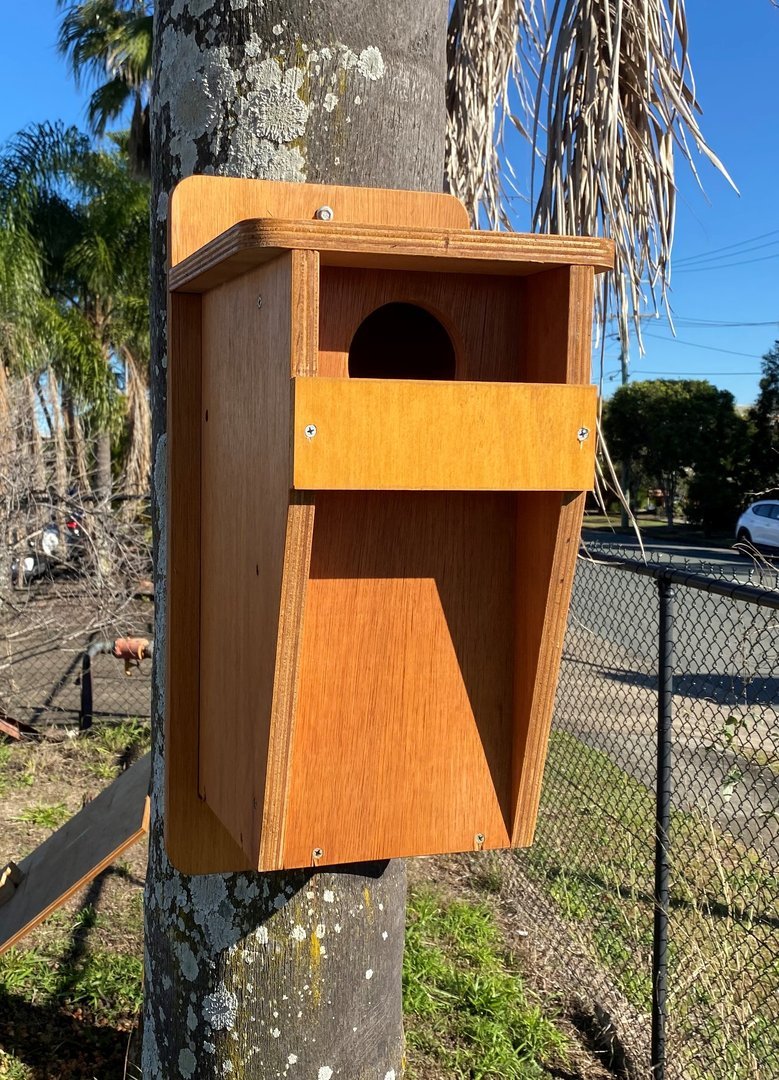Nest boxes: what some people get wrong

Seeing a plywood nest box tucked amongst the branches of a tree or hoisted around its trunk is a familiar sight to many Australians. But how effective are these well-intentioned makeshift homes at housing Australia’s unique and diverse wildlife?
Australia has some of the highest rates of land clearing in the world. While we flatten forests for urban development and agriculture, roughly a quarter of our animals rely on mature trees (and hollows) for nesting, breeding, feeding, and raising their young. These hollows are found in mature trees and formed over a long period of time. Current literature conservatively predicts that it takes at least 100 years for suitable tree hollows form. However, for large hollow-dependent fauna such as Powerful Owls and cockatoos, the timeframe is closer to 200 years.
Considering that many of these species are also crucial pollinators, its unnerving to recognise how little we are doing to rectify this problem. While nest boxes are implemented with good intention, they cannot hope to compensate for colossal habitat loss and degradation. Interestingly, most nest boxes are the result of community action such as neighbourhood efforts, local bushcare groups or schools. This reflects a love of wildlife common in your typical Aussie households and communities.
Despite being one of the main tools we have to mitigate habitat loss, various studies have shown that the common plywood nestboxes do have some significant shortcomings. This highlights an urgency to maximise the efficiency of these habitat substitutes and also to trial alternative methods where possible.
It’s beginning to be understood that these structures do have setbacks that eco-conscious individuals and wildlife lovers should be aware of when installing one in their backyard or local park. However, there are also some simple-enough ways to help your local wildlife make the most of its temporary shelter. Here are some things to consider.
1. Not too hot, not too cold
The first major issue with traditional nesting boxes is their lack of insulation. Think of a poorly constructed home that is scorching in summer and struggles to retain heat throughout winter. The same can be said of most wooden nesting boxes. A study done in south-east Queensland recorded temperature variance in nest boxes of up to 20°C within a 24-hour period. This puts young birds and mammals at risk of overheating, freezing to death, or having their parents simply abandon the nest. If you or your community are considering installing nest boxes, consider durable and insulating materials that may help buffer temperature change. This could mean, for example, using durable hardwood in place of plywood, and covering it with insulating batts of polystyrene or foil.
2. Going the distance
When it comes to nest box longevity, there is often room for improvement. Water damage, mould, destruction by wildlife and a susceptibility to being overrun by ants and bees mean ongoing replacement and maintenance of these boxes is required. A study on nest box longevity suggests the average lifespan of a plywood nest box is between 5 and 10 years. These studies are usually conducted in the natural environment, so backyard nest boxes may have an advantage in this instance, as they are generally more controlled and protected from damage and deterioration. So if installing nest boxes as part of a community project, remember that it’s important to keep monitoring them and plan for their repair or replacement over the years.
3. Getting the architecture right
Finally, box design is a huge predictor of species presence. Traditionally, boxes have followed a relatively generic blueprint which means they may not be suitable or attractive to local species. A recent study has concluded that entrance size significantly impacts which species may occupy a nest box. Different species have different needs and preferences for their hollow-substitutes. Research the species in your area and if you would like to target a species, look at their nesting preferences and try to cater your nesting boxes accordingly. There are free resources available to help design species-specific nest boxes in your area, such as these nest box plans from Birds in Backyards.

Nesting Box Alternatives
Given that there are some intrinsic limitations to nesting boxes, it’s reassuring to know that there are viable alternatives making their way onto the mainstream market. Local companies such as:
Habi-tec(in Queensland) and TreeFX and Melbourne Tree Care (in Victoria) have successfully combined arboriculture and conservation in their business models. This offers local councils, homeowners and property developers sustainable and ethical options to tree maintenance and/or removal.
Services such as felling and pruning allow as much habitat as possible to remain, while still being safe. Trees destined for removal can occasionally be cut to a safe level and then retained, with artificial hollows installed. Leaving standing habitat trunks can be highly cost-effective due to the large amount of work involved in removing tree trunks and is a great option for homeowners should they want or need to alter trees on their property.
Whether utilised by councils, homeowners or communities, artificial hollows are a huge step towards reconstructing natural and practical habitats. Whilst there is no replacement for a real, mature hollow-bearing tree, individuals do have options at their disposal to minimise the impact of devastating habitat loss.
Artificial and mechanically excavated hollows boast several qualities that make them more suitable than generic nest boxes. They remain insulated and natural-looking, and withstand the test of time.
Plywood nesting boxes are a great concept for habitat substitutes – now let us embrace some tweaks and fine-tuning to improve these vital refuges for our urban wildlife.




